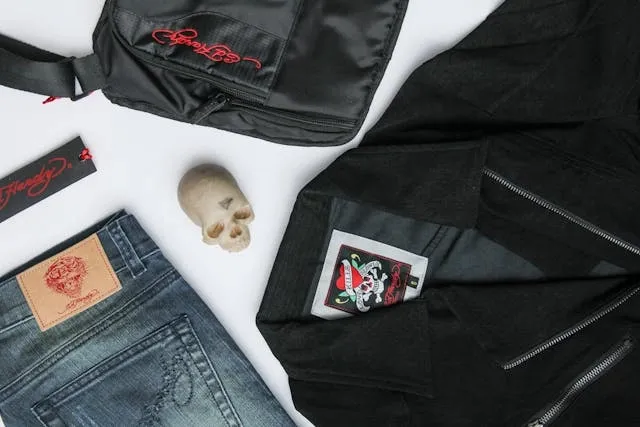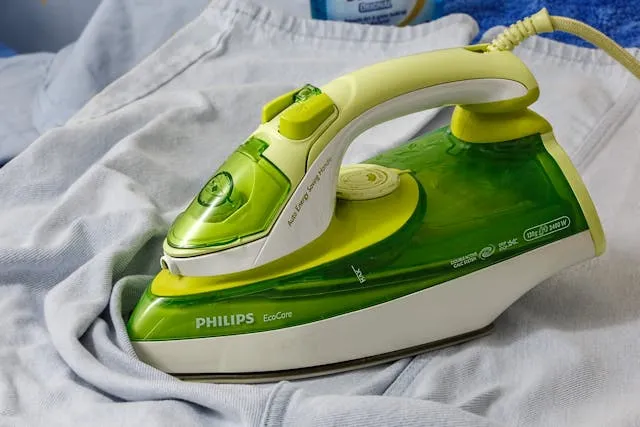How To Iron On Patches: Instructions For Best Results In Denim, Jerseys & Old Clothes
When you know how to iron on patches, you have a versatile solution from personalizing apparel from denim jackets to jerseys, hats, and even bags. In this guide, we explore how you can update your old clothes and achieve the best results when applying iron-on patches. Whether you’re breathing new life into aging favorites or adding flair to something new, learn how to put iron-on patches on effectively with our insightful guide.

Key Takeaways
- Iron-on patches are a simple, effective solution to modify or update your clothing in creative ways.
- You can apply them with an iron to activate the adhesive on the patch backing for a strong, durable attachment.
- Different clothing materials come with different considerations, so pay close attention to care instructions for a safe and effective adhesion process.
- You can reinforce iron-on patches with fabric glue or stitching for a stronger bond.
- We supply high-quality custom iron-on patches to enable you to personalize your apparel in creative ways and tailor your look.
Table of contents
-
How To Iron On Patches?
-
What Are The General Instructions To Put Iron-On Patches?
-
How Do Iron-On Patches Work On Clothes?
-
How To Iron On A Patch To A Jersey?
-
How To Iron-On Patches To Jean And Denim Jackets
-
Can You Iron On Adhesive Patches?
-
How Long Do You Iron On Patches?
-
Why Do Some Patches Stick Better Than Others?
How To Iron On Patches?
Iron-on patches tips can help you get the best results from this straightforward process to customize your apparel. You will need the following materials:
- The clothing you want to personalize
- An iron-on patch
- Your iron
- An ironing board
Ensure your garment is clean and flat before you start, then place it on the ironing board and position the patch carefully, adhesive side down. Cover with parchment paper or a thin cloth and firmly press the preheated iron onto it for 10-15 seconds. Always allow the garment to cool before testing the bond.
This method works to iron a patch to a backpack, jacket, or any other apparel, and our custom iron-on patches allow you to personalize your look with virtually no limits. Always make sure the patch is compatible with your fabric and the design is a good match for your chosen apparel.

How Do You Get Patches To Stay On?
To ensure a secure attachment when learning how to iron on a patch, you must set your iron to the appropriate temperature as instructed by the patch manufacturer. It is also important to apply even pressure during the application process.
Adhesion failure can happen, and here are some common reasons (and solutions):
- Insufficient heat or pressure: Try again with a higher iron temperature and apply more pressure for a longer period.
- Improper fabric selection: Double-check that the fabric of your garment is compatible with iron-on patches.
- Inadequate prepping of the garment: Ensure the garment’s surface is clean, dry, and smooth before attempting to apply the patch.
These steps will help you achieve a secure bond when ironing on patches.
What Are The General Instructions To Put Iron-On Patches?
The general instructions for how to iron on patches are as follows:
- Preheat the iron as instructed by the patch manufacturer, and be mindful of safe temperatures for the fabric.
- Place the patch on the desired location, adhesive side down.
- Cover with a thin cloth or parchment paper to protect the patch and the garment.
- Apply firm pressure with the hot iron across the patch for the duration specified in the patch instructions.
- Allow everything to cool completely before handling.
Some people choose to further reinforce the bond by adding a few stitches around the edges of the patch. If you feel uncertain about anything, there are many video tutorials on platforms like YouTube to provide a visual guide to the attachment process.
Create custom patches that are easy to iron on
Our custom patches offer extensive creativity and use high-quality heat-activated adhesive to make it easy to iron onto your apparel and achieve a secure attachment.
How Do Iron-On Patches Work On Clothes?
Iron-on patches bond to clothing through a heat-activated adhesive on their backing. You can make them work aesthetically on your clothing by envisioning where the patches should go for maximum impact. When you design with us, you can customize jeans and jackets, or even create custom iron-on patches for hats.
Here are some ideas for inspiration:
- Jeans: Consider adding a patch to the pockets, thighs, or cuffs for a casual yet striking look.
- Jackets: Common patch placements on jackets include sleeves, chest, or back for a bold statement.
- Hats: These are a unique canvas, and can accommodate patches on the front, side, or even the rim for added flair.
Experiment with placement ideas to achieve the aesthetic you want, and remember to learn how to adhere iron-on patches effectively for best results.
Mixing And Matching Patches For Personal Style
By mixing and matching patches, you can add flair and personality to your attire. Once you know how to iron on patches, you can experiment with different design features like:
- Patch types
- Sizes
- Themes
Our custom patches can be personalized with all these design features and more to create a unique statement. Our customers have tried ideas like clustering smaller patches around a larger one, or scattering patches randomly for a playful, eclectic look. Alternatively, you could arrange patches along seams or edges for a polished appearance.
Don’t be afraid to mix different styles to showcase your personality and creativity.
Transforming Old Garments With Patches
Learn how to iron on patches to transform old garments, breathing new life into tired clothing. If you have a worn-out denim jacket, a faded pair of jeans, or a plain t-shirt, adding patches can quickly rejuvenate their appearance. This will cover up imperfections like holes or stains and also add a touch of style and personality.
Work with us to create custom iron-on patches and experiment with different design features like:
- Materials
- Colors
- Shapes
- Sizes
- Bespoke graphics and text
Once you have your patches, you can also try creative placements to cultivate a one-of-a-kind garment that reflects your individuality.
Extend the lifespan of your wardrobe and express creativity and fashion aptitude. With a few patches and a little imagination, you can revive your old clothes in trendy, personalized ways.

How To Iron On A Patch To A Jersey?
When you iron a patch onto a jersey, you need to take care with the iron temperature and pressure to ensure you achieve a secure bond without damaging the synthetic fabric. Following the garment’s care instructions is crucial, but you will typically need to set your iron to a medium heat and apply gentle pressure during application.
Here are some common suggestions:
- Place a thin cloth or parchment paper over the patch to protect the fabric’s surface.
- Press the iron over the patch evenly for about 10-15 seconds.
- Allow it to cool before testing the adhesion.
It may be wise to add some stitches around the patch edges for extra durability. This could help maintain the bond on flexible materials that are prone to stretching and movement.
Add a custom patch to your hat with no hassle
Our custom iron-on patches for hats make it simple to enhance your hat’s aesthetic, and the techniques in this article will achieve a strong attachment.
Get startedHow To Iron-On Patches To Jean And Denim Jackets
There are some specific considerations to know when considering how to iron on patches to jeans. You should start by preheating your iron to the cotton setting, ensuring you have deactivated the steam function.
The step-by-step method is as follows:
- Lay the denim garment flat on your ironing board.
- Position the patch on the desired spot and cover with a thin cloth or parchment paper.
- Apply firm pressure with the iron, moving it in a circular motion for 30-60 seconds.
- Allow to cool, then check the patch edges to ensure a full adhesion.
For extra durability, some stitches around the edges can give you extra peace of mind that the bond won’t diminish over time. This is particularly helpful in high-wear areas like pockets and hems.
The Right Way To Apply Patches To Denim For A Long-Lasting Effect
When learning how to iron on patches to denim jackets and jeans, durability is key. We design our patches to achieve long-lasting adhesions on a wide range of materials, but here are some tips to get maximum durability on denim:
- Make sure the denim is cleaned thoroughly before application so no dirt or residue can interfere with adhesions.
- Preheat the iron to the cotton setting and switch off the steam function.
- Apply very firm pressure when ironing the patch onto the denim, with a slow, circular motion for even heat distribution.
- Allow the patch to cool completely before you wear the garment.
You should also take extra care when washing the jeans or jean jacket to protect the patch adhesion. Some extra stitches around the patch edges can make a big difference to longevity.
Common Mistakes To Avoid When Ironing Patches On Jean Jackets
To enjoy maximum durability when learning how to iron on a patch to denim, avoid these common mistakes:
- Insufficient cleaning: Applying a patch to a dirty jacket can undermine the adhesion.
- Incorrect iron temperature: If the heat is too low or too high, you may end up with a weak adhesion or you might damage the fabric.
- Inadequate pressure: If you don’t apply sufficient pressure during the application process, the bond may not be complete.
- Uneven heat distribution: You should move the iron evenly across the patch to achieve a consistent bond all over.
- Premature wearing: If you handle the garment before the patch has fully cooled, the adhesion may not be complete and the patch may come off.
Can You Iron On Adhesive Patches?
Iron-on patches feature a heat-activated backing, which is what you must trigger when learning how to iron on patches. When we talk about our custom adhesive patches, we are generally referring to our convenient peel-and-stick patches that create a temporary bond and don’t require an iron-on process.
One thing you can do is use other adhesives to reinforce iron-on patches. Options include:
- Fabric glue
- Silicone glue
- Double-sided adhesive tape
You will need to apply a thin layer of glue to the patch’s edges before ironing, or affix double-sided tape beneath the patch, for a stronger adhesion. Always follow the manufacturer instructions for the patches and additional adhesives to ensure the best possible results.
Brand uniforms and accessories easily with custom designs
Our custom brand logo iron-on patches make it straightforward to iron on branded patches to uniforms and more to strengthen your company’s visual identity.
How Long Do You Iron On Patches?
Applying heat is crucial for how iron-on patches work, and timing is a key consideration for achieving a secure attachment. Here are some general guidelines:
- For thinner patches and lightweight fabrics, 10-15 seconds of heat exposure usually creates a strong bond.
- For thicker, denser fabrics, you may need to apply heat for 20+ seconds to ensure proper adhesion.
You should always aim to use steady, even pressure throughout the ironing process for maximum adhesive activation. Refer to the instructions provided by your patch manufacturer for optimal temperature and timing. We supply comprehensive instructions for all our patches to ensure you have all the guidance you need to achieve optimal results..
How Do I Apply An Iron-On Patch?
Best practices for how to iron on patches effectively start with good preparation of both the garment and the rion.
- Ensure the fabric is clean and dry.
- Preheat the iron to the appropriate temperature as instructed by the patch manufacturer.
It is possible to iron on patches without an iron, but clothes irons offer the simplest solution. Take your time selecting the right patch position and aligning it correctly before you apply heat from the iron. And always use a layer of thin cloth or parchment paper, as prolonged exposure to direct heat could be damaging to the patch or the garment.
As you apply the patch, press down firmly with the iron and move it in a slow, circular motion for the recommended duration. And always allow the garment to cool before handling it so that the adhesive can set properly.
Do You Use Steam Or Dry Iron For Iron-On Patches?
Generally, steam is not recommended for how to iron on patches as it can interfere with the adhesive’s effectiveness. If your iron’s steam setting is on, the patch may not adhere properly. However, in materials like sturdy cotton or heavy-duty denim, steam may be acceptable in some circumstances. Always refer to the specific instructions from the patch manufacturer and exercise caution with steam to ensure optimal adhesion.

Why Do Some Patches Stick Better Than Others?
When you learn how to iron on a patch, you will find that adhesive strength can vary due to a number of factors. These include:
- The quality of the adhesive used: High-quality adhesives tend to have superior bonding qualities and longevity.
- The patch material: Smooth, clean surfaces provide better adhesions than rough, textured ones - this applies to the garment as well.
- Application technique: Applying sufficient heat and pressure during ironing are crucial to achieve a strong bond.
You should try to avoid stretching the fabric whilst the adhesive is setting. If the patch doesn’t bond well on the first attempt, you can remove iron-on patches and reapply with better technique, or including fabric glue and/or stitching for a stronger bond.
Different material, same straightforward iron-on application
Our custom vinyl iron-on patches offer a different look and a robust feel, and it is simple to press them onto clothing and accessories with an iron for a reliable attachment.
Create yoursFrequently Asked Questions About How To Iron On Patches
How To Iron On Patches?
To iron on patches, you should lay the clean, dry garment on a flat surface and position the patch adhesive side down. Apply heat and pressure with the iron for the recommended duration.
How To Iron On A Patch To A Jersey?
Jerseys are made from synthetic materials with a stretchy design so be sure to follow the instructions carefully. Use a medium heat and moderate pressure and consider adding stitches around the patch for a stronger attachment.